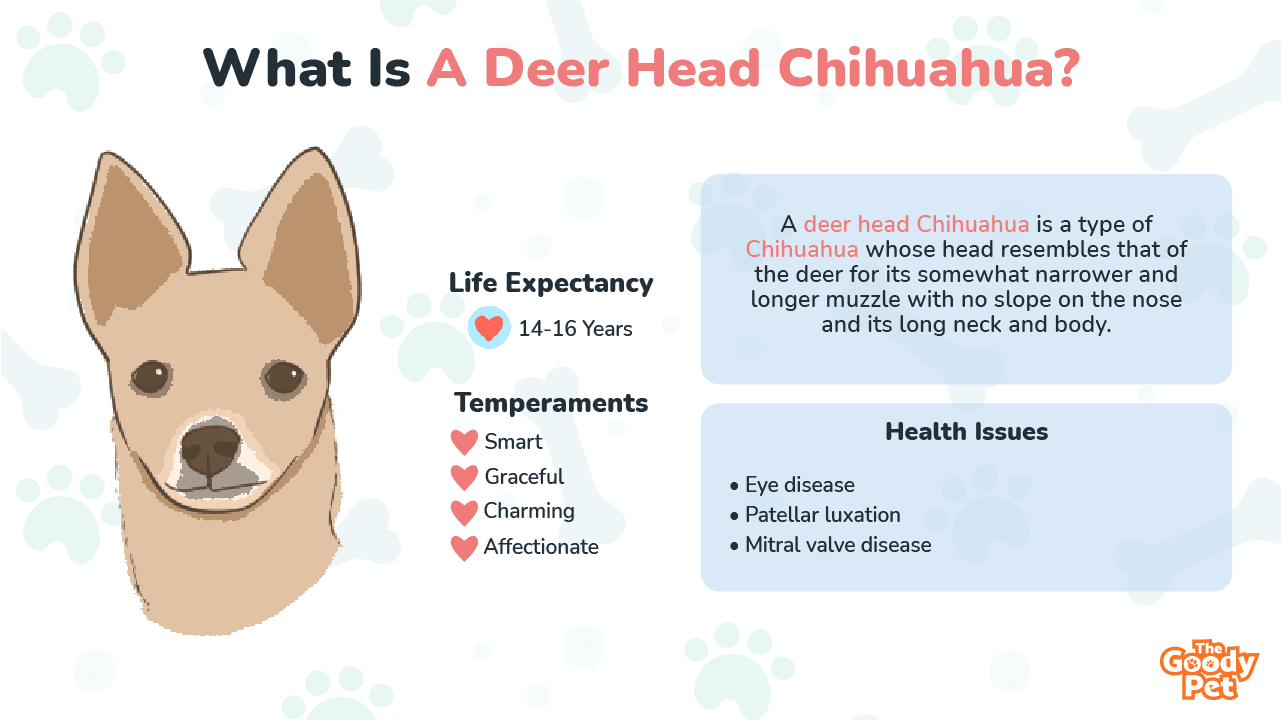I’ve always thought a Chihuahua was a Chihuahua, that tiny pocket dog with a huge personality. But my thinking was challenged the other day when a friend asked me if I would prefer a Deer Head Chihuahua over other types like the Apple Head and the Pear Head. That made me curious, and I started researching Chihuahua types. So, what is a Deer Head Chihuahua?
A Deer Head Chihuahua is a type of Chihuahua whose head resembles that of the deer for its somewhat narrower and longer muzzle with no slope on the nose and its long neck and body. While the Deer Head is largely similar to other types, it is only fancied by owners and breeders but is not recognized as a breed standard by the American Kennel Club.
In this article, we tell you the difference between the Deer Head Chihuahua and other types by considering its appearance and temperament. We also tell you how often you expect to see a Deer Head Chihuahua in homes or a fancier’s pocket, how long it lives, and the health issues that affect this breed. If you’ve ever wondered whether Chihuahuas are purebreds, we’ll give you some succinct details about that too.
What Do Deer Head Chihuahuas Look Like?
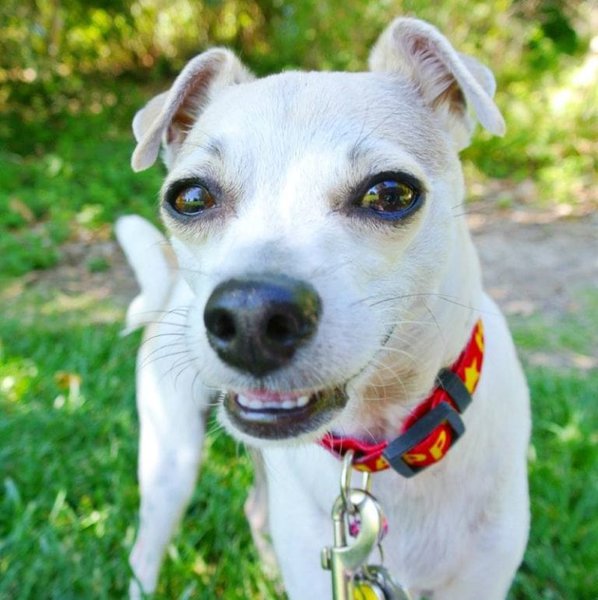
The Chihuahua is famous for its tiny size, which is why it is placed among the toy breeds. You’ve certainly heard about Chihuahua dogs that can fit in your pocket or a teacup. But how big does a Deer Head Chihuahua get?
General Head And Body Appearance
The Deer Head Chihuahua has most of its physical features similar to those of other types. However, it has a longer neck and body and a narrower well-shaped head and skull that resembles that of the deer. The head may have or lack a molera, the hole in the head that looks like the soft spot on the head of human babies.
Chihuahua Weight
Chihuahuas don’t grow very big. They are faithful to their tiny size and will not grow heavier than 6 pounds. As a breed standard, any dog presented for a Chihuahua with over 6 pounds is disqualified, according to the Chihuahua Club of America (CCA).
Chihuahua Length And Height
The Chihuahua’s body is a little longer than it is high. Generally, however, the dog will grow to a height between 5 and 8 inches. Males tend to have shorter bodies than females.
The Fore And Hindquarters
At the forequarters, the Chihuahua has lean raised shoulders that drop into wider support at the forelegs. This gives the little canine ease of movement at the elbows.
At the hindquarters, the Chihuahua is muscular and sturdy at an angle equal to the forequarters. The level back allows a well-formed chest and balance for the forequarters.
Are Deer Head Chihuahuas Rare?
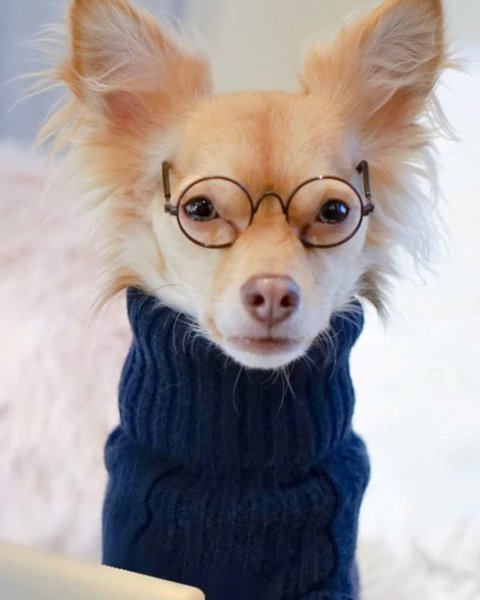
If we go by the AKC breed ranking, Chihuahuas are a relatively common breed, ranked 33rd out of the 195 breeds recognized by the club. However, there is nothing to indicate that the Deer Head type of Chihuahua is more common or rarer than other types.
Some people will use color to describe the rarity of the Chihuahua types, with Fawn and Black Chihuahuas being more common while the pure White and Blue Chihuahuas are said to be rarer. According to the CCA, these variations can be used to hike prices among breeders.
It’s important to note that most breeders will list their dogs simply as Chihuahuas, without indicating the type. If you are considering owning a Chihuahua you can opt to buy a puppy or adopt an adult one.
Buying A Chihuahua
A quick check of breeders listed on the CCA and the gooddog.com search site indicates that Chihuahua prices will average between $2,000 and $3,500. Some breeders may, however, go as low as $650. As seen on some breeder websites, prices will vary depending on factors like bloodline, location, age, and sex, with female Chihuahuas tending to cost more than males.
Adopting A Chihuahua
If you have a small budget but still want a Chihuahua pet, you can opt to adopt one from a rescue shelter. Chihuahua dogs listed for adoption on petfinder.com can be adopted for as low as $200, which would be 10 times less than a $2,000 price tag. But your decision to adopt will depend on whether you want a young or mature dog.
How Long Do Deer Head Chihuahuas Live For? Common Health Problem Of A Deer Head Chihuahua
The AKC gives the Chihuahuas a life expectancy of 14 to 16 years, but some will say that it falls between 15 to 20 years.
A 20-year-old Chihuahua is a rare case, as was Megabyte, the longest living Chihuahua on record from the US who lived for 20 years and 265 days.
To help your Chihuahuas live a long life, health conditions common to this breed should be kept at bay. These include heart problems, like mitral valve disease and patent ductus arteriosus. Idiopathic epilepsy, eye disease, and loose knee cups (patellar luxation) are also threatening conditions for the breed.
The CCA recommends three OFA tests for every Chihuahua.
Cardiac Test
To screen for mitral valve disease and patent ductus arteriosus which tend to affect smaller breeds as they age. Breeding Chihuahuas should be screened for the same every year.
Patella Test
This test involves manipulating the dog’s kneecap and classifying it on a 0-4 grade. It should be done around 6 to 8 weeks, but for OFA certification, the Chihuahua must be one year old or older.
Healthy kneecaps can be enhanced with food supplements rich in Glucosamine like Zesty Paws Mobility Bites For Hip & Joint.
Eye Tests
This test rules out ophthalmic disease and should be done by a board-certified veterinary ophthalmologist.
Hypoglycemia
As with other toy breeds, Chihuahuas do not store fat as readily. This can lead to hypoglycemia, or an imbalance in the production and utilization of blood glucose, leading to low blood sugar. Supplementing your puppy with Nutri-Vet Puppy-Vite High Calories Dietary Supplement will help restore this balance.
It provides a generous amount of calories for your Chihuahua to balance out the lack of glucose in their blood and prevent the symptoms of hypoglycemia like panting and shaking.
Are Deer Head Chihuahuas Mean? Temperament Of A Deer Head Chihuahua
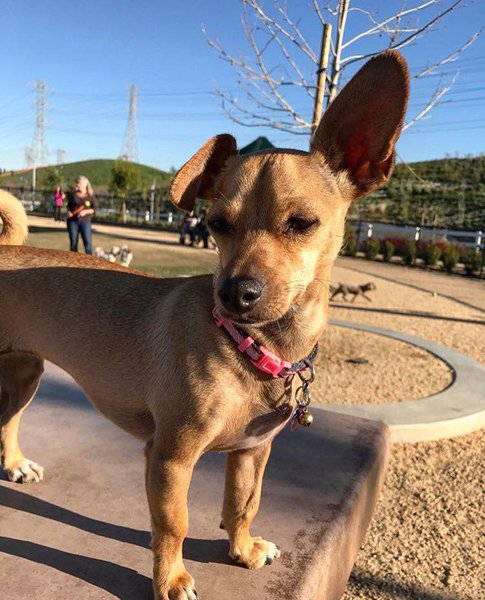
The Deer Head Chihuahua is not much different in temperament from the other types. The breed is described as graceful, charming, affectionate, loyal, loving, alert, smart, and easy-going. These qualities make the Chihuahua be likened to the Terrier breed.
Chihuahuas require calm and patient handling. They will not put up with the rough handling of kids, even though the pet and kids can be trained to handle each other appropriately. They will also appreciate a cuddle on your lap, especially when the weather is cold.
Some owners suggest that the Deer Head Chihuahua is less meaningful than other types because it tends to be less aggressive and more obedient. But no studies have confirmed that yet.
Despite their small size, Chihuahuas are often said to have a big-dog attitude and can become the kings and queens of the home if they are left to have their way. Some will describe this attitude as the ‘small dog syndrome.
The Chihuahua’s tiny size is thought to be responsible for the breed’s ‘dislike’ towards other dogs and pets, though it will get along well with fellow Chihuahuas. Care should be taken that its big-dog-ego does not get your Chihuahua hurt by other pets. Early training and socialization are important.
Other temperament minuses of the Chihuahua are its tendency to have a favorite member of the family with whom it bonds exclusively and its excessive barking. While this makes it a great watchdog, it can be a bother for neighbors if you live in an apartment.
What’s The Difference Between An Apple Head And A Deer Head Chihuahua? How About A Pear Head Chihuahua?
Officially, Chihuahuas are differentiated by a long or short coat. Other types are used among breeders, owners, and Chihuahua fanciers. They include:
- Deer Head Chihuahua
- Apple Head Chihuahua
- Pear head Chihuahua
- Teacup Chihuahua
- Fawn Chihuahua
While a Teacup Chihuahua can imply that it can fit into a teacup, a Fawn Chihuahua is described by its color. The remaining three are described by the difference in their head shape. The Deer Head and the Apple Head Chihuahuas are more popular. Here are a few aspects that differentiate the two types.
Deer Head Chihuahua
- A narrow head that resembles that of the deer
- Longer muzzle with a slight slope on the forehead
- Slightly longer neck and body
- Less pronounced eyes
- Longer jawline
- Larger ears mainly appear erect
Apple Head Chihuahua
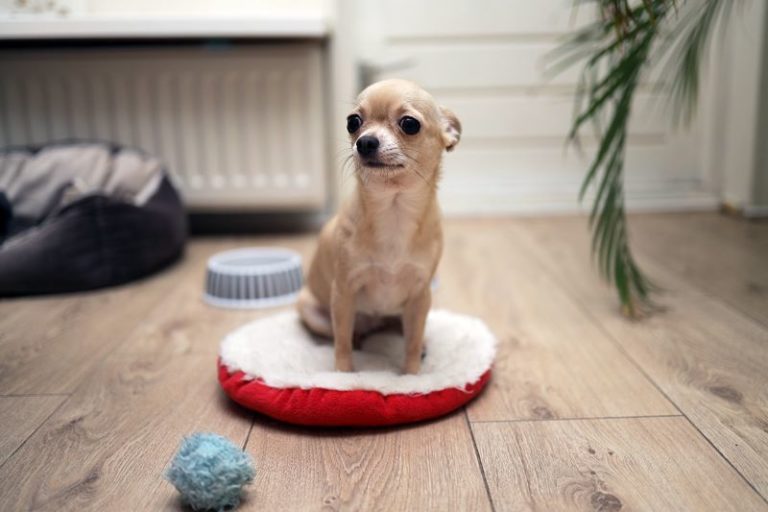
- A round head likened to an apple shape
- Slightly shorter muzzle with a sharp 90° slope at the forehead
- Shorter neck and body
- More prominent and eyes
- Shorter jawline
- Smaller erect-appearing ears
A less popular type is the Pear Head Chihuahua. It is more like the Deer Head Chihuahua but has a flatter skull and grows larger than the Deer Head. Some will maintain that Pear Heads result from breeding Deer Heads and Apple Heads.
Related Questions
How Can I Tell If My Chihuahua Is Purebred? You can do a DNA test to check whether your Chihuahua is purebred, but this is costly. The most common way is by registering your dog with the country’s kennel club so that it is cleared for breed standards. For the AKC, the hallmarks of a Chihuahua are a rounded apple head structure and an overall weight not exceeding 6 lbs.
Are Deer Head Chihuahuas Smart? It is said that the Chihuahua has a short attention span, but people who own Chihuahuas consider them able to quickly learn new tricks and commands. If we go by the word of the dog psychology expert Stanley Coren, Chihuahuas are not intelligent dogs and only rank 125 out of 138 breeds.
Are Deer Head Chihuahuas Purebred? Going by the Chihuahua breed hallmark indicated by the AKC, Deer Head Chihuahuas are not purebred. It is said that the Deer Head Chihuahuas result from breeding a Deer Head and an Apple Head. Considering that the Apple Head is the recognized breed standard, then the Deer Head is considered the mixed type of Chihuahua.

